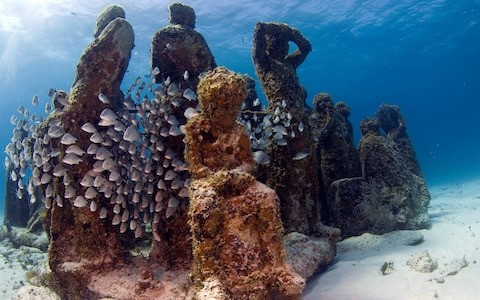- September 1, 2020
- Posted by: Andrew Caetano
- Category: Innovation

When a structure is intentionally placed on the seafloor, it can create habitat for a variety of marine life. For this reason, artificial reefs are often popular destinations for divers, snorkelers, and local fishermen.
Many reefs are built using objects that were built for other purposes, for example by sinking oil rigs (through the Rigs-to-Reefs program), scuttling ships, or by deploying rubble or construction debris. Other artificial reefs are purpose built (e.g. Reef Pyramids) from steel or concrete. Shipwrecks are also another form of artificial reef when preserved on the sea floor.
The first artificial reefs were built by the Persians to block passages for boats in ancient times. The next reason for artificial reefs is to increase the amount of fish in a specific area and with it the yield for fisheries.
Why build an artificial reef?
Research suggests that in some instances, artificial reef may divert some pressure away from natural reefs while still allowing the visitors to enjoy diverse marine life. Artificial reefs can also have a positive impact on local economy as many tourists, snorkelers, and anglers charter boats through local businesses. In such an instance, the artificial reef would be considered a ‘win-win’ for the economy and the environment.
Artificial reefs help to prevent coastal erosion by either forcing waves to break further away from the beach or to hold sediment on the shallow areas. Artificial reefs are also built to break the waves at a certain point allow more days when surfing is possible or create the perfect waves.
Artificial reefs play a central role in the restoration of coral reefs that have been destroyed by human impact or natural disasters like storms or El Niño. Using the right material for the structures which is like a natural basis for coral growth and transplanting coral to it allows restoration of lost reefs hopefully faster than they would regrow naturally.
A good example is Jason Taylor, an English artist who has created an entire underwater museum of sculptures in Mexico. The museum is a popular tourist attraction, which successfully serves its purpose of drawing tourists away from the fragile natural reefs nearby.
Image: Museo Subacuatico de Arte, Cancun, Mexico
What are the disbenefits of artificial reefs?
There are possible negative effects of artificial reef structures too. Some projects have failed and ended up doing more harm than good. In one case, huge amounts of old tires were sunk to the ocean floor to form an artificial reef. This was a great way to get rid of existing waste however do not offer a good foundation. The tires ended up getting loose and washed up on natural coral reefs nearby destroying the intact structures on their way towards shore. So choosing the right material for the artificial reef is key feature in the design of artificial reefs.
Therefore, to ensure that the desired economic benefits of artificial reefs are achieved extensive planning, evaluation and permitting must occur before any artificial reef can be deployed within the sea.
Credits: www.morefundiving.com, getty images.


